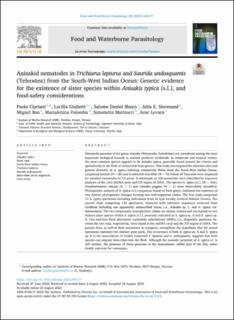| dc.description.abstract | Nematode parasites of the genus Anisakis (Nematoda, Anisakidae) are considered among the most important biological hazards in seafood products worldwide. In temperate and tropical waters, the most common species appears to be Anisakis typica, generally found around the viscera and sporadically in the flesh of various fish host species. This study investigated the infection sites and genetic diversity of A. typica infecting commercial fishes from the South-West Indian Ocean. Largehead hairtail (N = 20) and brushtooth lizardfish (N = 72) fished off Tanzania were inspected for anisakid nematodes by UV-press. A subsample of 168 nematodes were identified by sequence analyses of the cox2 mtDNA gene and ITS region of rDNA. The species A. typica (s.l.) (N = 166), Pseudoterranova ceticola (N = 1) and Anisakis paggiae (N = 1) were molecularly identified. Phylogenetic analysis of A. typica (s.l.) sequences based on both genes, indicated the existence of two distinct phylogenetic lineages forming two well-supported clades. The first clade comprised 12 A. typica specimens including individuals from its type locality (central Atlantic Ocean). The second clade comprising 154 specimens, clustered with reference sequences retrieved from GenBank including one apparently undescribed taxon, i.e., Anisakis sp. 1, and A. typica var. indonesiensis. The two reciprocally monophyletic clades are closely related and correspond to two distinct sister species within A. typica (s.l.), presently indicated as A. typica sp. A and A. typica sp. B. Two and four fixed alternative nucleotide substitutions (SNPs), i.e., diagnostic positions, between the two taxa, respectively, were found at the mtDNA cox2 and the ITS region of rDNA. The genetic data, as well as their occurrence in sympatry, strengthens the hypothesis that the actual specimens represent two distinct gene pools. The occurrence of both A. typica sp. A and A. typica sp. B in the musculature of freshly examined T. lepturus and S. undosquamis, suggests that both species can migrate intra-vitam into the flesh. Although the zoonotic potential of A. typica s.l. is still unclear, the presence of these parasites in the musculature, edible part of the fish, raises health concerns for consumers. | en_US |
